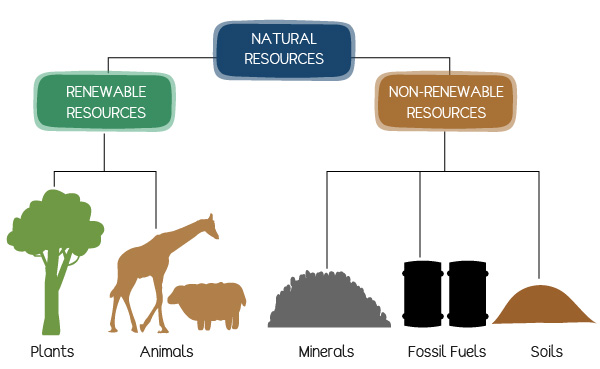- Natural Resources
Types of natural resources
Natural resources fall under two main categories: Renewable and Non-renewable Resources. The table below will help us understand this better.

Renewable resources
Renewable resources are those that are regularly available (like water) or can be reasonably replaced or recovered, like vegetative lands. Animals are also renewable because, with a bit of care, they can reproduce offspring to replace adult animals. Even though some non-renewable resources can be replenished, they may take many years, and that does not make them renewable.
Renewable resources that come from living things such as trees and animals can be called organic renewable resources.
Renewable resources that come from non-living things such as water, sun, and wind can be called inorganic renewable resources.
Non-renewable resources
Non-renewable resources are those that cannot be replaced once they are destroyed. Examples include fossil fuels. Minerals are also non-renewable because even though they form naturally in a process called the rock cycle, they can take thousands of years, making them non-renewable. Some animals can be considered non-renewable because if people hunt for a particular species without ensuring their reproduction, they will be extinct. That is why we must ensure that we protect resources that remain endangered.
Non-renewable resources can be called inorganic resources if they come from non-living things. Examples include minerals, wind, land, soil, and rocks.
Some non-renewable resources come from living things — such as fossil fuels. They can be called organic non-renewable resources.
Metallic and Non-metallic Resources
Inorganic resources may be metallic or non-metallic. Metallic minerals are those that have metals in them. They are harder, shiny, and can be melted to form new products. Examples include iron, copper, and tin. Non-metallic minerals have no metals in them. They are softer and do not shine. Examples include clay and coal.
